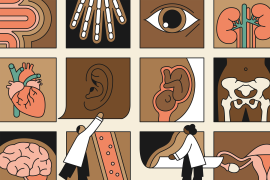Save or print all individual charts from this chartbook in ChartCart.
You can watch a video or listen to audio from a May 12th Alliance for Health Reform/Commonwealth Fund briefing, Racial and Ethnic Disparities: States and Feds to the Rescue?
Introduction
Many Americans are in poor health and do not receive the best medical care. While these problems affect people of all groups and walks of life, the challenges are especially acute for racial and ethnic minorities. Myriad research studies and reports have documented that minorities are in poorer health, experience more significant problems accessing care, are more likely to be uninsured, and often receive lower quality health care than other Americans.1,2 These differences may be caused in part by factors such as income, education, and insurance coverage. But even after adjusting for these determinants, disparities often persist. Given the rapidly growing diversity of this nation, an increasing number of minority Americans find themselves at risk of disease and not getting the care they need.
The goal of this chartbook is to create an easily accessible resource that can help policy makers, teachers, researchers, and practitioners begin to understand disparities in their communities and to formulate solutions. Given the magnitude of the body of disparities research, we do not intend to create an exhaustive report that simply presents existing data. Rather we seek to prompt thinking about why these disparities may exist, and more importantly, what may be done to eliminate these gaps. Our hope is to offer a systematic set of data coupled with a discussion that we hope can educate a broad audience about the challenges and opportunities to improve the health and health care of all Americans.
This chartbook also incorporates an evolving understanding of the nature and etiology of disparities. Many studies have pointed to the role of bias, miscommunication, lack of trust, and financial and access barriers in allowing disparities to occur. This chartbook also reflects emerging evidence that disparities may be a function of the overall performance of the health system where one lives, or of the quality of providers that care for many minorities. Hence, some disparities observed in national analyses may be due to failures in the health care system that result in barriers to care for minorities. Other disparities may be due to minorities disproportionately living in regions where quality is suboptimal or receiving care from providers whose quality similarly needs improvement. Understanding these underlying dynamics will help policy makers and health professionals design the most effective strategies for reducing disparities.
The chartbook is divided into the following chapters:
The Demographics of America highlights the changes in the United States' population. It presents information on the population by race/ethnicity, income, and language.
Disparities in Health Status and Mortality addresses disparities in a number of the focus areas of the Healthy People 2010 Initiative.
Disparities in Access to Health Care offers a picture of the challenges minority Americans face in receiving needed health care. This chapter includes information on access to primary care, as well as more specialized services.
Disparities in Coverage provides a snapshot of why insurance coverage varies by race and ethnicity.
Disparities in Quality documents that racial and ethnic disparities exist across all the domains of quality articulated by the Institute of Medicine.
Strategies for Closing the Gap includes a sample of the modest but growing body of knowledge on strategies that may lessen or eliminate disparities in health and health care.
The United States leads the world in health care spending, yet this has not translated into better health or assurances of access to high quality health care for all its residents. Conscious, thoughtful action will be needed to confront and address disparities with changes in policy, as well as a redesign of many parts of our health system. Disparities pose a major challenge to a diverse 21st century America. A first step in meeting this challenge will be ensuring we have the information we need.
Notes
1. Agency for Healthcare Research and Quality, National Healthcare Disparities Report. 2003–2006.
2. Institute of Medicine, Unequal Treatment: Confronting Racial and Ethnic Disparities in Health Care (Washington, D.C.: National Academy of Sciences, 2003).



